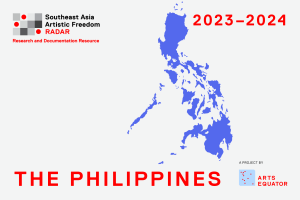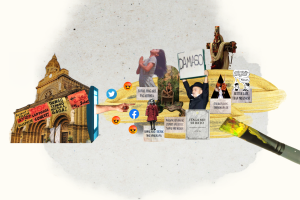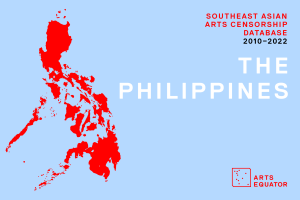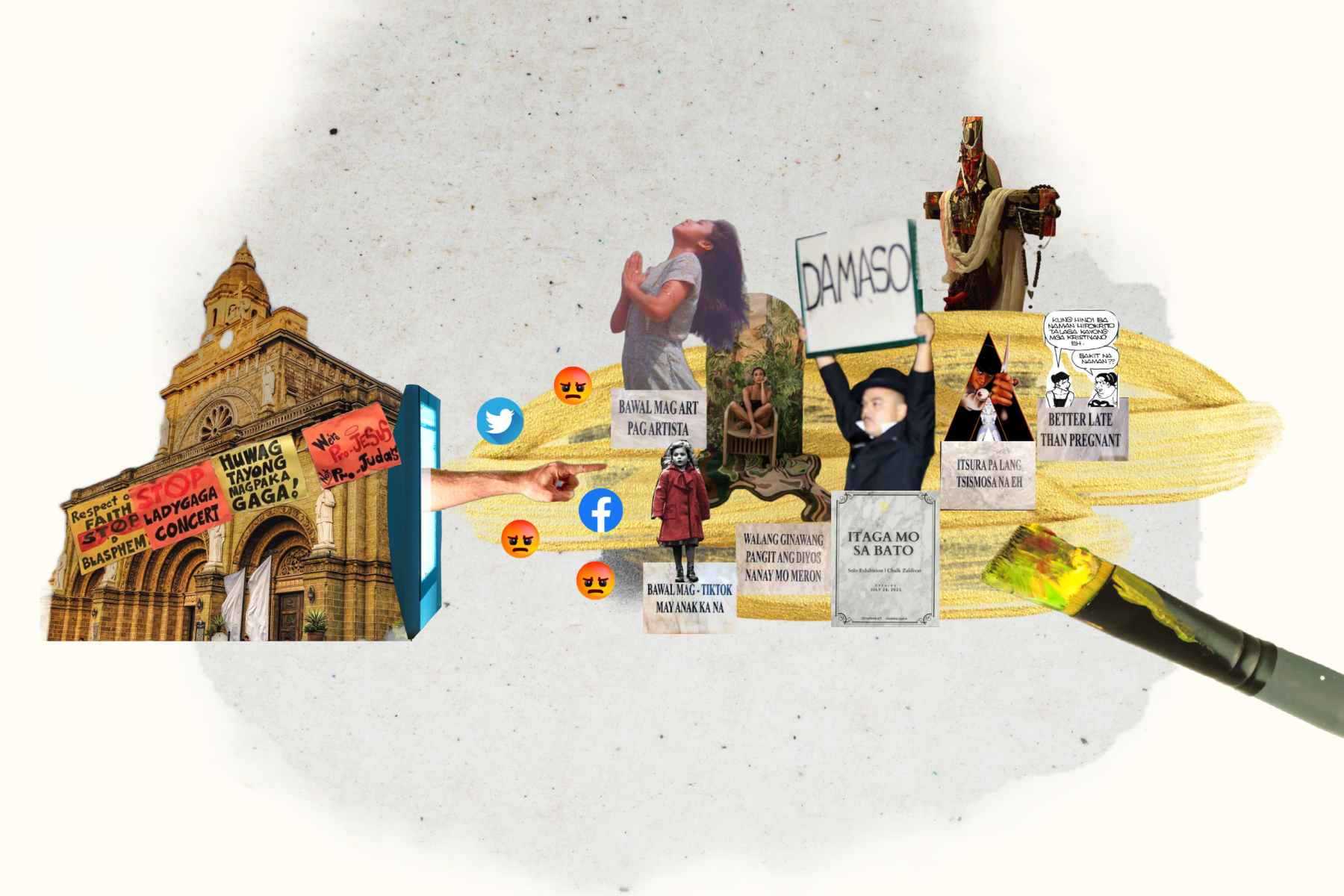If censorship is the weapon, conservatism are its bullets.
In contexts where there is a clear and powerful right-wing, conservatism stands strong against liberalism and democracy. Lines are clearly drawn on issues, and polarization holds for most of discourse. But in landscapes like the Philippines, where the socio-political cannot simply be divided between left and right, many issues are necessarily complicated by the push-and-pull among political factions, some premised on ideological differences, other times on lesser, trivial divides.
One of those issues is arts and culture censorship. And in heavily fractured socio-political contexts, artistic work and creative labor face bigger risks of repression, whether in the form of outright censorship, or the more insidious forms of silencing. In places like the Philippines, this is more complex than it sounds: the instigators are not your usual suspects, and targets are as diverse as they come.
That this is rarely talked about, fleshed out, and discussed, only makes matters worse: difficult conversations are such because they are urgent and necessary. When we refuse to have them, we end up suppressing dialogue that is indispensable to contemporary discourse on censorship, artistic and otherwise.
Martial Law maneuver
This is not to say that we do not talk about arts and culture censorship at all. It is to say that when we do so, we mostly only tie it to one moment when it was wielded as weapon at scale.
In the Philippines this moment would be Martial Law, as imposed by Ferdinand Marcos Sr. in 1972.¹ His order to close all privately-owned television, film, and radio facilities on September 22 , and to jail any person who prints, publishes, possesses, or circulates written or drawn print materials that might incite the people to defy government on October 28² of the same year, are testament to a dictatorship that lived off the suppression of artistic rights and freedoms. While the basis for these two orders could simply be seen to be about controlling criticism and anti-government propaganda, what it glosses over is the belief that the citizenry is so intellectually ill-equipped that they will easily be swayed in any political direction, including towards rebellion.
Since the People Power Revolution of 1986 ousted Marcos and his family, the Martial Law era has been held up as proof of the worst kind of artistic repression. But that also raises more difficult conversations that are met with evasion. There’s the truth that despite institutional censorship, the era gave birth to important, critically-acclaimed work across the arts, and established cultural institutions that continue to be relevant. And then there’s the fact that we have failed to assess arts and culture across the six Presidents since 1986, as if it is unworthy of discussion without repression.
Yet it would be a lie to say that artists and cultural workers have lived with untrammeled freedom since the ouster of the Marcoses; it would also be a lie to say that since censorship has not been the policy of any government since Marcos, then it does not exist at all. In fact, tracking post-Marcos censorship reveals how often it’s been wielded as weapon, and how it harks back to Marcos era reasoning.
In January 1986, an anonymous Filipino journalist was quoted by the Los Angeles Times: “The censors treat us like children. We cannot grow up that way—but maybe they don’t want us to grow up” [… so we will continue] “to think of ourselves as slaves.”³
Four months earlier, on October 5 1985, Marcos had signed the Presidential Decree that would create the Movie and Television Review and Classification Board (MTRCB)⁴ that was to decide if a film or TV show is fit for exhibition in the country based on what it called the standard of “contemporary Filipino cultural values.” To this day, this office exists as a body that judges, regulates, classifies, and decides if a TV or movie is fit for exhibition in the country. In 2020, at the height of the Covid-19 pandemic, MTRCB even sought to wield its power over online streaming services like Netflix, to ensure that it “complies with Filipino contemporary values.” ⁵
Democracy and conservatism
The newly installed democratic government of President Cory Aquino in 1986 (in)famously believed that “culture is not a priority.”⁶ Even then, it didn’t mean that arts and culture could live free of censure. Instead, what it normalized was a particular brand of Catholic conservatism which, through Aquino, dictated which cultural products were “fit” for public consumption. Aquino was a devout Catholic whose rise to power came with support from the Catholic Church and the requisite iconography of religious statues and prayer. The return to democracy and creative freedom could only be burdened by this conservatism in leadership. That Aquino allowed the MTRCB to continue to exist is telling: after all, if censorship highlights a distrust of the people’s ability to decide on what is good and bad art, then Aquino (as does the Church) held on to this distrust.
This distrust of course was different across the Marcos and Aquino leaderships. The former’s censorship was part and parcel of Martial Rule and was particularly interested in ensuring that no cultural product would, as the Presidential Decree that created the MTRCB states, “incite subversion, insurrection, rebellion or sedition against the State, or otherwise threaten the economic and/or political stability of the State.”
On the contrary, the Aquino leadership from 1986 to 1992 normalized governments with a clear public stance against the censorship of the arts, while appointing censors chiefs who could shamelessly assert that “Sex [in film] is detrimental to the people. If a person is poor and he gets horny, he’s just going to rape,”.⁷ This kind of thinking led to the banning of films like “Clockwork Orange” (1971) and “Schindler’s List” (1993).
Assertions that speak of “the morality of Filipino culture” are intricately tied to the (domineering) notion that the Philippines is a Catholic country, which necessarily puts culture and the arts at risk of being attacked in the name of religion’s morals and truths. Aquino and the presidents that followed her tended towards clamping down on artistic work that were “offensive” as based on a very subjective notion of morality.
Interestingly, when former President Rodrigo Duterte started publicly flouting Catholicism’s unspoken rules—making rape jokes, objectifying women, threatening to kill citizens—and blatantly treated the Catholic Church as enemy, this did not mean he eschewed conservatism.
Instead, he espoused a conservatism tied to his stand against legal militant Leftist organizations. Five years out of Duterte’s six, these organizations and its activists suffered State attacks, from red-tagging to mass arrests to extrajudicial killings. His government also employed a propaganda strategy⁸ that used the “protection” of the youth as the reason behind their anti-Left campaign.
In doing so, the government espoused a conservatism that insists that the youth—college students and young adults—are incapable of making decisions for themselves. In this equation, the youth are always but “victims” of Leftist (i.e., Marxist) ideology, ”trapped” in organizations that turn them into “rebels.” In 2018, 18 schools were tagged as “recruitment ground” for Leftist organizations, and with it came the accusation that it is culture—films⁹ and books¹⁰—that is used for recruitment efforts. It is for this reason that a clamp down on films deemed as “leftist” such as Martial Law films like Kip Oebanda’s Liway to library books published by Left organizations, or written by authors deemed as leftist—have been targeted by the State. Leftist cultural workers and artists have been thrown in jail, such as members of artist collective Panday Sining.¹¹
On the one hand, this kind of artistic censorship under Duterte is cut from the same cloth as Marcos, speaking as it does of subversion and inciting to rebellion. On the other hand, across all presidents after Marcos, conservatism is a common thread that surfaces as a reaction to diverse cultural products that are deemed as immoral and unfit for public consumption.
In this landscape, the public is infantilized, justifying the State’s goal of controlling what culture the public consumes, and blocking any creativity that is deemed detrimental to the safety and care of citizens, even as it can lay claim to the notion that there is no censorship because the Philippine Constitution clearly states that “no law shall be passed abridging the freedom of expression.”
Snapshots of cultural censorship
Given the above context, what we see in the censorship of arts and culture over the past decade or so would come as no surprise. It is a by-product of three decades of democracy, with no censorship on paper, but with the freedom to be offended—and act on that offense—at any given time, in whatever context. To some extent, this landscape is even more dangerous for arts and culture: after all, artists can only prepare for attacks if they know what it’s supposed to look like and where it might come from.
But in recent years, censorship has been used as weapon in ways that have yet to be named, as it has been wielded by unusual suspects.
This is of course not unique to the Philippines. PEN America’s Artists At Risk Connection looks at censorship in all its complexity, as instigated by State and non-state actors, through various ways and across different spaces, including the digital, where both public and private groups are identified as possible sources of censure.
In the Philippines, the complexity of censorship is in the fact that even as there has been a growing number of instances in which it happens, these are usually denied by both its State and non-State instigators. In fact, it would be no surprise if a snapshot of varied instances of contemporary censorship of arts and culture would warrant an attack or two—we would rather think hierarchically about the harms of censorship, where one “kind” is worse than the other, instead of seeing these acts as different manifestations that are detrimental to creative freedom and artistic expression, full stop.
That of course makes putting it on paper even more imperative.
Two presidents—one devout Catholic, the other anti-Catholic—refused to confer the National Artist Award to an actress and icon chosen by her peers in arts and culture. The basis for their refusal: that she is no role model, given dismissed drug charges on her public record.¹²
A noontime show’s reality-dating segment which focuses on a woman’s search for love is censured by a militant-feminist organization for being exploitative—never mind that the woman is an adult who consented to this process.¹³
An international pop icon holding a concern in Manila is accused of being “a symbol of everything corrupt and demonic.”¹⁴
Musicians lose work to an online mob, where the loudest, often nameless, collective will always win at cancellation.¹⁵
Artists’ exhibitions are ”cancelled” online by civil society actors, for everything from PR photos that are guilty of “poverty porn,”¹⁶ to failing to create “emancipatory spaces” for the LGBTQIA+ community.¹⁷ One statement against the exhibition, “satire lost on the people will be the weapon of the oppressor”, disturbingly echoes the State’s historic infantilization of the public.
An art installation is deemed blasphemous and taken down by the Cultural Center—along with the group exhibit it appeared in after media framed the work as anti-Church and the religious backlash ensued.¹⁸
A performance artist enters a church carrying a sign that harks back to the Spanish Colonial Era Catholic repression, in protest of the Church’s stance against reproductive health bill, and is jailed for “offending religious feelings.”¹⁹
A comics writer is forced to resign for talking about lesbianism in an exclusive Catholic girls’ school in his comics strip.²⁰
Thirteen human rights organizations call for the removal of a Netflix series on the Duterte drug war—before it even premieres.²¹
Many of the cases above reveal the continued normalization of conservative beliefs and ideology as reason for creative repression, but now instigated, not by the state, but primarily by non-State actors.
Other cases may be driven by new urgencies—under the rubric of addressing systemic inequalities of class or gender—that deserve to be interrogated. However, the enactment of outrage in recent cases appear to result in conversation-ending “cancellation” of artists or removal of artworks—censorship in a word—rather than accountability and discourse.
It is important to deepen the discussion with regards to the common tone, tenor, and language used to discuss “offensive” work and actions, by both the state and non-state agents. More research is necessary, but early indications show a troubling replication of the State’s methods—call for take downs, online cancellations, boycotts, and un-publication. After all, employing the loudest (collective) voice calling for censorship of works based on offense and outrage is easy. That these acts are justified by saying it is for the “greater good,” or “the safety of all,” is telling—dictators and fascists say the same thing after all.
This predisposition also evades what would arguably be the more difficult task—to battle things out in the arena of creativity, a film for a film, a book for a book. To support artistic expression, no matter how flawed, by challenging works we disagree with, and generating new discourses, counter-works, counter narratives instead of removing and calling for the banning of works, or the silencing and de-platforming of artists.
In 2012, in the face of massive protests from Catholic religious groups against her concert, Lady Gaga said to a packed stadium: “I am not a creature of your government, Manila!” She then proceeded to sing the song “Judas.”
It would be good to start wondering now how many of us have become the creatures we seek to slay.
This content is produced as part of a project to research and document arts and culture censorship in Southeast Asia, organised by ArtsEquator.
Katrina Stuart Santiago is a writer and cultural critic from Manila, with a 15-year writing practice across mainstream and fringe publications, in print and on digital. Her creative practice has fueled her activism, which cuts across issues of cultural labor, systemic dysfunctions, and institutional crises, and how these are tied to bigger issues of nation and governance. She is founding director of small press, bookshop, and gallery Everything’s Fine, co-author of UNESCO-Germany's Fair Culture Charter, and collaborator of the Feminist Journalist Network of the Association for Women in Development. She heads the civil society organization People for Accountable Governance and Sustainable Action-PAGASAph that seeks to provide the space for political action from younger civil society actors, and was 2023 Public Intellectual of the Democracy Discourse Series of the Southeast Asia Research Center and Hub of the De La Salle University. Through Everything's Fine she is constantly redefining her practice as an independent cultural worker, as she nurtures communities that seek safe, kind, and productive spaces for difficult conversations and relevant dialogue. She writes at katrinastuartsantiago.com and is @radikalchick online.
- Katrina Stuart Santiagohttps://radar.artsequator.com/author/katrina-stuart-santiago/
- Katrina Stuart Santiagohttps://radar.artsequator.com/author/katrina-stuart-santiago/
- Katrina Stuart Santiagohttps://radar.artsequator.com/author/katrina-stuart-santiago/
- Katrina Stuart Santiagohttps://radar.artsequator.com/author/katrina-stuart-santiago/
Similar Reads





